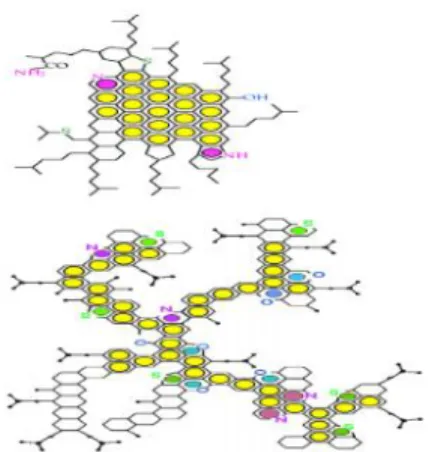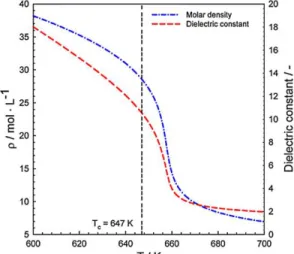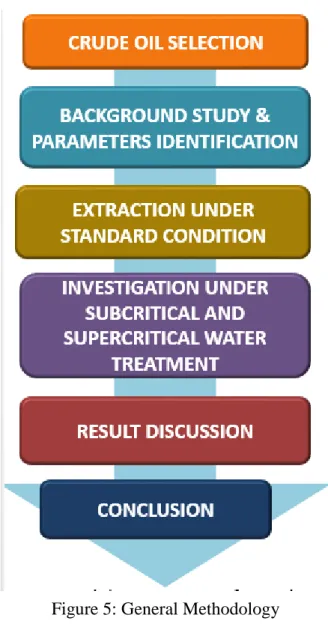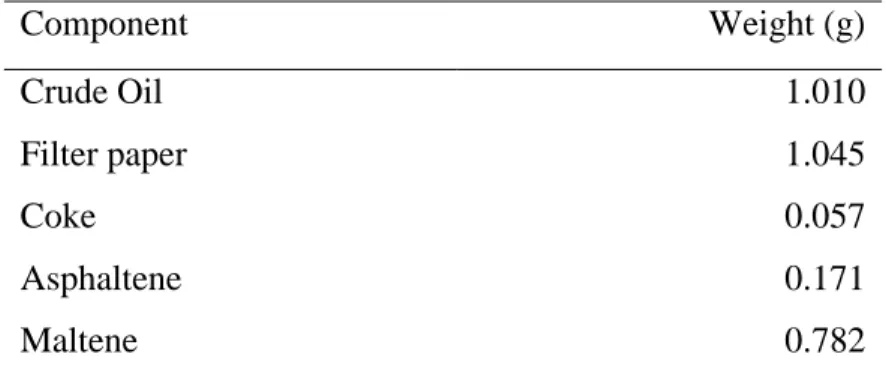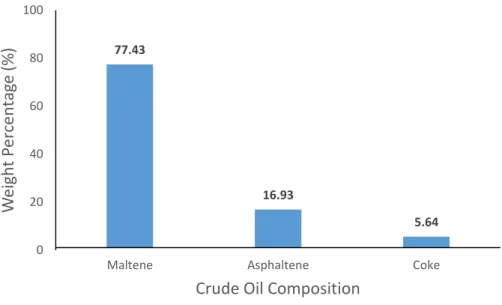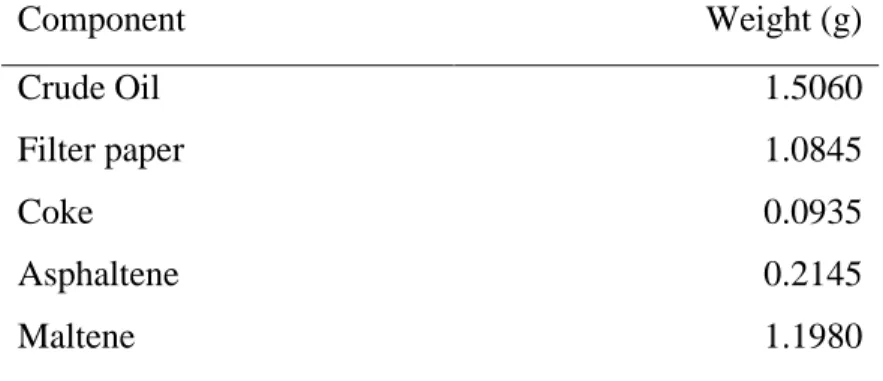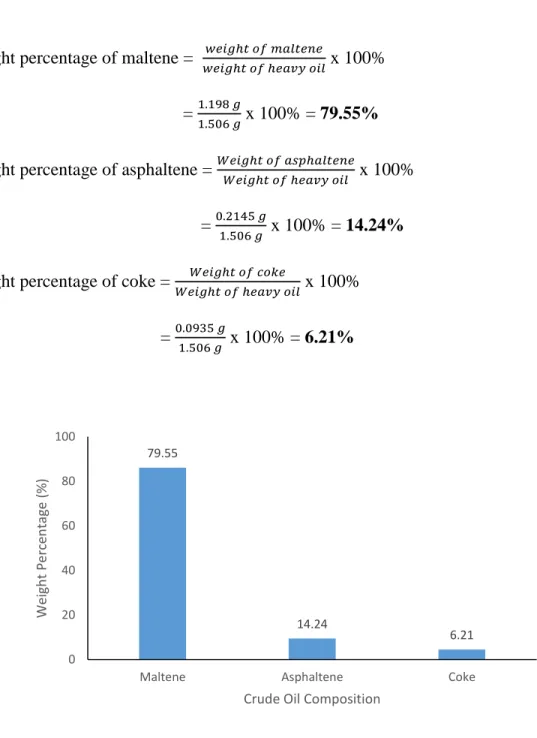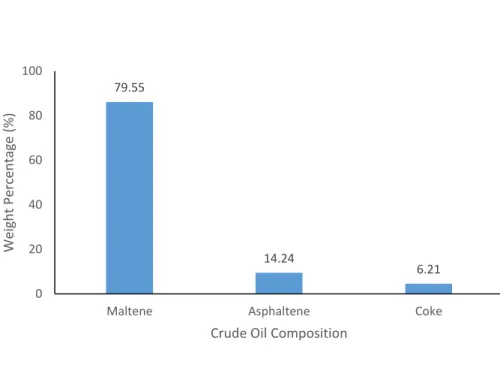i
Investigation of Asphaltene under Subcritical Water Treatment
By
Mohamad Azmi Bin Alias 14392
Dissertation submitted in partial fulfilment of the requirement for the
Bachelor of Engineering (Hons) (Petroleum)
SEPTEMBER 2014
Universiti Teknologi PETRONAS Bandar Seri Iskandar
31750 Tronoh Perak Darul Ridzuan
ii
CERTIFICATION OF APPROVAL
Investigation of Asphaltene under Subcritical Water Treatment By
Mohamad Azmi Bin Alias 14392
A project dissertation submitted to the Petroleum Engineering Program Universiti Teknologi PETRONAS In partial fulfilment of the requirement for the
BACHELOR OF ENGINEERING (Hons) (PETROLEUM)
Approved by,
__________________________
Dr. Pradip Chandra Mandal
Petroleum Engineering Department Universiti Teknologi PETRONAS
UNIVERSITI TEKNOLOGI PETRONAS TRONOH, PERAK
SEPTEMBER 2014
iii
Certification of Originality
This is to certify that I am responsible for the work submitted in this project, that the original work is my own except as specified in the references and acknowledgements, and that the original work contained herein have not been undertaken or done by unspecified sources or persons.
________________________
(MOHAMAD AZMI BIN ALIAS)
iv
Abstract
Crude oil becomes heavier leads to the increasing of demand for lighter hydrocarbon in the market. High amount of heavy components such as asphaltene and coke in the crude oil nowadays makes it becomes heavier. Heavy oil which contains high amount of asphaltene is less valuable in the refining process compares to the lighter oil that contains lighter component which is maltene. It is because the valuable products like kerosene, diesel, petrol fuel and many more are extracted from the maltene. Thus, many researches and studies had been done to invent heavy oil upgrading technology.
Apparently, the traditional upgrading process of heavy oil which are coking, vis-breaking and solvent de-asphalthing have low efficiency and have high operation cost.
This project will come out with two respective objectives which are to extract maltene, asphaltene and coke from heavy oil under the standard condition and also to investigate the reaction behavior of asphaltene under subcritical water treatment.
Separation process of maltene and asphaltene will be completed by the chemical reaction between heavy oil and n-heptaneas well as toluene solution. Then, the heavy oil will undergo transformation process under subcritical water state.
The extraction process under standard room condition shows weight percentage;
77.43% of maltene, 16.93% of asphaltene and 5.64% of coke. After the subcritical water treatment in which the crude oil been heated together with water at 100°C for 30, 60, and 90 minutes, the result showed increasing amount of maltene which was 86.11% and reduction amount of asphaltene; 9.40%.
As the conclusion, the subcritical water treatment succeeded to turn the heavy oil into the lighter oil as there are the increasing amount of maltene and reduction amount of asphaltene.
v
Acknowledgements
First and foremost, all praise to Allah, the Almighty for giving me the opportunity to successfully complete the Final Year Project (FYP) for about 28 weeks at Universiti Teknologi PETRONAS. I would like to express my gratitude and appreciation to those who were involved in helping me on ensuring the successfulness of my Final Year project.
Special thanks to Dr Pradip Chandra Mandal from Petroleum Engineering Department, my supervisor, who was responsible to supervise myself throughout my project period. His guidance, endless support, encouragement and supervision is very valuable towards my learning process in finishing my project and accomplishing the goals of Final Year Project.
I would like to express my sincere gratitude to my FYP Coordinator, Dr Syahrir Ridha from Petroleum Engineering Department for his guidance and supervision during my Final Year Project. Under his supervision, I gained a lot of experience and knowledge as a final year student.
Finally, I would like to deliver my utmost appreciation to my parents, whom never giving up in inspiring and supporting me to accomplish this program. Last but not least, a lot of thanks to my fellow colleagues and clique, who contributed explicit or implicitly towards accomplishing the objectives of the industrial internship.
With their supports, guidance, teachings and suggestion, it really help me to enhance my self-development, knowledge and attitude towards the process of my project and accomplishing the goals of Final Year Project program.
vi
Table of Contents
CERTIFICATION OF APPROVAL ... ii
Certification of Originality ... iii
Abstract ... iv
Acknowledgements ... v
Chapter 1: Introduction ... 1
1.1 Background ... 1
1.2 Problem statement ... 3
1.3 Objectives ... 4
1.4 Scope of studies ... 5
Chapter 2: Literature review ... 6
2.1 Heavy crude oil ... 6
2.2 Asphaltene... 7
2.3 Supercritical Water Treatment ... 8
Chapter 3: Methodology ... 11
3.1 Key milestone ... 11
3.2 Gantt chart ... 12
3.3 Extraction procedure under standard room condition ... 14
3.4 Experimental Procedure under Subcritical Water Treatment for 30, 60 and 90 minutes .. 17
Chapter 4: Results and Discussions ... 19
4.1 Results ... 19
4.1.1 Extraction at Standard Room Condition ... 19
4.1.2 Extraction at 100ºC for 30 minutes ... 20
4.1.3 Extraction at 100ºC for 60 minutes ... 22
4.1.4 Extraction at 100ºC for 90 minutes ... 23
4.2 Discussions/Findings ... 25
4.2.1 Extraction under standard room condition ... 25
4.2.2 Extraction under subcritical water treatment (100°C) for 30, 60 and 90 minutes... 27
Chapter 4: Conclusion and Recommendation ... 31
4.1 Conclusion ... 31
4.2 Recommendation ... 31
vii
References ... 32
Appendices ... 34
List of Figures
Figure 1: Water phase Diagram ... 2Figure 2: Heavy oil Properties; Viscosity vs Temperature ... 7
Figure 3: Structure of Asphaltene ... 8
Figure 4: Dielectric Constant of Water at 25Mpa ... 9
Figure 5: General Methodology ... 13
Figure 6: Extraction Flowchart ... 14
Figure 7: Heavy oil mix with n-heptane ... 15
Figure 8: Filtration of Heavy oil and n-heptane ... 16
Figure 9: Heating process in water bath ... 17
Figure 10: Weight Percentage of Maltene, Asphaltene and Coke under Standard Room Condition ... 20
Figure 11: Weight Percentage at 100 degree C for 30 minutes ... 21
Figure 12: Weight Percentage at 100 degree C for 60 minutes ... 23
Figure 13: Weight Percentage at 100 degree C for 90 minutes ... 24
Figure 14: Asphaltene and Coke Precipitation ... 25
Figure 15: Coke Precipitation ... 26
Figure 16: Asphaltene and coke precipitation after 60 minutes subcritical water treatment ... 27
Figure 17: Asphaltene and coke after subcritical water treatment for 90 minutes ... 28
Figure 18: Graph based on standard room condition and subcritical water treatment ... 29
Figure 19: Formation of Butane from Butyne-2 ... 30
Figure 20: Formation of Ethane from 2-Phenyl-Ethylene-1 ... 30
viii
List of Tables
Table 1: Key Milestone ... 11
Table 2: Gantt Chart ... 12
Table 3: Experimental data under standard room condition ... 19
Table 4: Experimental data under subcritical water treatment for 30 minutes ... 20
Table 5: Experimental data under subcritical water treatment for 60 minutes ... 22
Table 6: Experimental data under subcritical water treatment for 90 minutes ... 23
Table 7: Weight Percentage of compositions under standard room condition and subcritical water treatment... 29
1
Chapter 1: Introduction
1.1 Background
Recent years shows that crude oil has become heavier and indirectly causes the high demand of lighter crude oil. Moreover, the amount of asphaltene as well as coke have been higher than ever. In result, the composition of lighter petroleum which consist of maltene is dwindling nowadays. As the lighter crude is more valuable in the refining process, the demand of this particular light crude has been increasing. Thus, the high amount of heavy crude oil need to be undergo transformation process to produce lighter crude oil. This project basically will focus on the extraction of maltene, asphaltene and coke in the crude oil and investigation of asphaltene under subcritical and supercritical water treatment which will focus on the transformation of asphaltene into maltene by using the treatment.
Crude oil basically consists of three major compositions which are maltene, asphaltene, and coke. Basically, the portion in the crude oil which can be dissolved in the n-heptane solution, is maltene. Maltene is the most valuable composition as it mostly be used in the refining process. In the refinery process, the valuable products such as petrol fuel, diesel and kerosene are extracted from the lighter component which is maltene. The remaining portion in the same crude oil which can be dissolved in the toluene solution, is asphaltene. Last but not least, the remaining portion in the crude oil, is coke.
However, this project focus on the reaction behavior of asphaltene under subcritical water treatment by conducting the laboratory experiment and in the further study, the experiment under supercritical water treatment will be conducted. After done with the treatment, the heavy oil sample undergo the the same procedure of extraction process to identify the weight percentage of the maltene, asphaltene and coke and result’s comparison are made.
2
Referring to the Figure 1, the subcritical water state is in between the triple point and the critical point. Thus, any temperature and pressure between it can be choose to meet the subcritical water state criteria. As this experiment, 100°C and 1atm were chosen as the treatment.
Figure 1: Water phase Diagram
Subcritical water properties in which the temperature is between 100ºC and 374°C and the pressure almost 1 atm until 221.1 MPa is suitable for the water to donate the hydrogen ion to the asphaltene structure to form a new chemical substance. Subcritical water treatment is very suitable chemical solvent as it can be used in many chemical reactions and also it is not only can acts as a solvent but it also can acts as a reactant.
3 1.2 Problem statement
Nowadays, lighter crude oil’s demand is increasing rapidly, while the crude oil recently becomes heavier. In addition, many valuable products like petrol fuel, kerosene and diesel are extracted from the lighter component which is maltene. There is many difficulties regarding the refining process by using the heavier component which consist of asphaltene. The traditional upgrading processes of heavy oil which are coking, vis- breaking, and solvent de-asphalting are not efficient. One of the efficient crude oil upgrading, catalytic process, cannot upgrade heavy oil due to its high viscosity and high conradson carbon residue.
Moreover, due to the decreasing amount of lighter crude oil, heavy oil such as tar, oil shale and bitumen need to be utilize in the near future. But, to utilize all those kind of heavy oil, a new upgrading technique of heavy oil is required (Watanabe, Kato, Ishizeki, Inomata, & Smith Jr, 2010b). Mostly, heavy oil consists of high amount of asphaltene.
Meanwhile, asphaltene is not the valuable composition in the crude oil which can be used in the refining process. Asphaltene normally will be used to produce the least valuable product which is tar as it is the heavier crude oil.
Besides, the presence of the heavier crude oil usually will cause side effect to the production as well as refining processes. Some scholars comes out with their research that asphaltene increases the viscosity of the crude oil as well as causes the blockage in the pipelines. This is due to the deposition of asphaltene in the pipeline and directly it will cost some money to do the cleaning of the pipeline which is pigging. Moreover, the presence of asphaltene in the crude oil will lead the stabilization of emulsion.
Thus, this project will focus on how to extract the asphaltene from the crude oil under standard room condition and how to transform the asphaltene (heavier) into maltene (lighter) under subcritical water treatment.
4 1.3 Objectives
This project came with two respective objectives which are to extract maltene, asphaltene and coke from heavy crude oil under standard room condition and to investigate asphaltene under subcritical water treatment. The details are shown below.
i. To extract maltene, asphaltene and coke from the crude oil under standard condition.
- Since the crude oil consists of three major compositions which are maltene, asphaltene and coke, the extraction process have been done under standard room condition to measure the weight percentage for all of them.
ii. To investigate asphaltene under subcritical water treatment.
- After done with the extraction process, the transformation process of asphaltene into maltene have been conducted by using subcritical water treatment. The result are compared and discussed.
5 1.4 Scope of studies
Based on the project, extraction of maltene, asphaltene and coke from heavy oil under standard room condition will be focused on. Some chemical solutions will be used in the extraction which are n-heptane solution and toluene solution. N-heptane will be used to dissolve the maltene portion in the crude oil. Toluene will be used to dissolve the asphaltene portion in the crude oil. With the dissolution of maltne and asphaltene, the weight percentage for each maltene, asphaltene and coke in the crude oil sample under standard room condition will be determined.
Besides that, transformation process of asphaltene into the maltene also one of the scope of studies. The subcritical (less thermal cracking) and will be used to transform the asphaltene into maltene. The reaction behavior of asphaltene during the treatment under the subcritical state will be studied for an example how the water donates the hydrogen ion to the structure of asphaltene and form another chemical component which is lighter.
How the thermal/heat can break the bond of the heavier structure to form a new lighter structure also will be studied. Only experimental under subcritical water treatment will be conducted in this project due to the feasibility issue which is time constraint. Further study on supercritical water treatment shall be done in the future.
However, some literature reviews regarding the supercritical water treatment have been done because it has almost same properties with subcritical water treatment. Some scholars highlighted that the supercritical water treatment acts as ‘thermal cracking’ and subcritical water treatment acts as ‘less thermal cracking’. It is because they have same properties and the only differences are their temperature and pressure used during the treatment.
6
Chapter 2: Literature review
2.1 Heavy crude oil
As global reserves of lighter crude oil continue to decline, increased reliance on heavy and unconventional crude oil will result in higher upgrading costs and more importantly a comparatively larger carbon footprint (Suoqi Zhao, Xu, Sun, Chung, &
Xiang, 2010). Heavy oil basically is one of the unconventional oil type which has API gravity approximately between 10º to 20º.
Some scholars come out with the total estimated heavy oil’s resources as well as bitumen which is 6.2 billion barrels, the increasing reserves of heavy oil leads to the high demand of lighter oil (Eng, Iqbal, & Niccum, 2008). Increase in sulfur levels and also processing of heavy oil which have high sulfur leads to the serious problem on quality of product as well as challenges in the processing conditions (S Zhao, Sparks, Kotlyar, &
Chung, 2007).
Heavy crude oil or bitumen are kind of oils in which have high viscosity and high density (Meyer, Attanasi, & Freeman, 2007). Thus, they have high resistance to flow and very low API gravity. However, the viscosity of the heavy oil reduced with the increment of temperature as shown in Figure 2. Based on the research, light crude oil has high API gravity which is more than 31.1°, medium crude oil has API gravity in between 22.3° to 31.1°, heavy crude oil has API gravity in between 10° to 22.3° and extra heavy crude oil has API gravity below than 10°. Extra heavy crude oil which having API gravity below than 10° is known as bitumen. To calculate the API gravity, the following equation can be used:
API = 141.5
𝑆𝐺 – 131.5; where SG is specific gravity of the oil.
Specific gravity is a ratio of density of any substances to the density of the reference substances and mostly the reference substance is water. Specific gravity does not have unit. It varies with pressure and also temperature.
7
Figure 2: Heavy oil Properties; Viscosity vs Temperature
2.2 Asphaltene
Asphaltene which presence in the crude oil brings many disadvantages to the transportation as well as refining process. Based on previous study, crude oil from Petrozuata has the highest percentage of asphaltene which is 18.8% (Appendix 1).
Asphaltene has potential to block the pipeline from the platform to the onshore terminal as the fine particle of asphaltene will clog the fluid flow in the pipeline and some cases asphaltene will accumulate and stick onto the pipeline and pigging operation should be done to clear the pipeline. Asphaltene will form due to the low temperature in the crude and also incompatible chemical reaction. The presence of asphaltenes also will increase the viscosity of the crude oil.
Besides, the high amount of asphaltene presence in the heavy oil will increase the time needed during the distillation of the crude oil due to its high viscosity. It is due to the difficulty of extracting the heavier and complex structure (asphaltene) as shown in Figure 3 compare to maltene which is lighter structure. Asphaltenes also contain high amount of sulphur in which required some treatments to refine it. That’s why the crude oil which does not contain sulphur is called sweet crude for an example Nigerian crude.
8
Figure 3: Structure of Asphaltene
2.3 Supercritical Water Treatment
Supercritical water (SCW) which has water properties, 374°C and 22.1 MPa which are beyond its critical point is very ideal choice to prevent the asphaltne from undergo precipitation process at the high cracking temperature which is over 400°C (Cheng, Ding, Zhao, Yuan, & Yuan, 2009). SCW had been under investigation as a solvent for a variety of chemical reaction such as extraction of natural products and nanostructured material synthesis (Bozbag, Sanli, & Erkey, 2012). Supercritical fluid has been investigated for heavy oil upgrading and with its unique properties, it can easily dissolve aromatics as well as light hydrocarbons (Akiya & Savage, 2002).
The most important parameter is to convert the heavy oil into lighter products by increasing the H/C ratio (Oballa, 1994). Moreover, due to the supercritical water state, ethers and esters, aromatic bonds as well as aliphatic bonds are easily to be broken up (Lachance, Paschkewitz, DiNaro, & Tester, 1999). Under supercritical state, two major reaction probably occur which are oxidation and hydrolysis (Goto, Nada, Ogata, Kodama,
& Hirose, 1998). Treated oil shale by using supercritical water, resulted in a higher conversion and also a larger oil recovery compare to the toluene extraction (Hu, Zhang, Guo, & Chen, 1999).
Supercritical water also contribute to more facile decomposition in oil shale polar components during the reaction compare to the supercritical toluene (Funazukuri, Yokoi,
9
& Wakao, 1988). Due to the decrease of the dielectric constant, water lost its polarity when it was in the supercritical state which leads its properties reorder the hydrocarbon properties and directly becomes great solvent for organic compounds as shown in Figure 4 (Canıaz & Erkey, 2014). Besides that, the solvation’s power will enable the extraction of the lighter compound as well as increased the [H3O+] ion concentration will make the extraction of heavy hydrocarbon becomes reactive.
Upgrading of heavy oil basically improving the ratio of H/C which either decrease the amount of particular carbon or increase the amount of particular hydrogen in the oil.
Simply can defined that current upgrading techniques are categorized into two groups which are carbon rejection and hydrogen addition. Additional, current technique used for hydrocarbon which are carbon rejection and hydrogen addition have their own disadvantages. For an example, hydroconversion/hydroprocessing upgrading technique, coke and metal deposition can simply deactivate the expensive catalyst, make the process failure. In fact, in hydroconversion technology, the process need to consume high amount of hydrogen while the hydrogen production units are currently one of the most costly technology.
Some researchers came out with the alternative where non catalytic carbon rejection technology is suit to replace the catalytic hydrogen addition technology, in result, will decrease the liquid product yield together with the high amount of coke formation
Figure 4: Dielectric Constant of Water at 25Mpa
10
which more economical (Ancheyta, 2011). Coke formation also can be reduced by using supercritical water (Mandal, Shiraishi, Sasaki, & Goto, 2011). Heavy oil usually has high percentage of asphaltene which leads to many problems during production and refining process (Ghanavati, Shojaei, & SA, 2013). Besides, the high amount of asphaltene also cause the high viscosity of the heavy oil. Petroleum or crude oil becomes heavier due to the high amount of the impurities such as nitrogen, sulphur, asphaltene and heavy metals (Watanabe, Kato, Ishizeki, Inomata, & Smith Jr, 2010a).
Thus, the demand of lighter crude oil has been increasing. In result, heavier crude oil such as heavier bitumens, oil shale and tar sand will be used in the refining process to replace the lighter crude oil in the future (Watanabe et al., 2010a). The presence of heavier crude oil (asphaltene) causes disadvantages which are the asphaltene will increase the viscosity of the crude oil as well as will block the pipeline which is used to transport the hydrocarbons. The presence of asphaltene also will cause the problem in the production and the refining processes.
Thus, this project will comes out with an upgrading technique to transform the asphaltene into lighter crude oil. One of the transformation technique is by using the supercritical water (SCW). Many researchers found that catalytic cracking, coke deposition that deactivates the catalyst is a serious problem (Watanabe et al., 2010a).
Moreover, many researchers found that hydrocracking which is one of the upgrading method for bitumen is very costly due to the hydrogen supply problem (Diono, Sasaki, &
Goto, 2008). Thus, other upgrading technique which is not using external hydrogen supplier are most desirable. Besides, the thermal cracking or pyrolysis of asphaltene which produce free radicals that could abstract hydrogen which from another asphaltene structure to form a new gas and maltene structure will lead to deficient of hydrogen of some core’s asphaltene (Han, Zhang, Bi, & Cheng, 2011).
One of the reason to use the supercritical water in upgrading heavy oil is both hydrogen and oils are miscible in the SCW. C-O and C-C bonds which commonly found in esters as well ether, and also C-S and C-H bonds which commonly found in the aliphatic are easily can be broken in the supercritical water. Gas and maltene are the product from the reaction of asphaltene and the supercritical water (Han et al., 2011).
11
Chapter 3: Methodology
3.1 Key milestone
The key milestones for this project are shown in the Table 1. All milestone have their own completed planned and to ensure the works will be delivered on time.
Table 1: Key Milestone
Project Milestone Planned timescale
Extraction of Maltene and Asphaltene from Heavy oil
October 2014
Investigation of Reaction Behavior under Subcritical Water
November 2014
To be seen clearly, below the author highlighted all the key project milestones in the Gantt-Chart provided.
12 3.2 Gantt chart
Table 2 shows the Gantt Chart for this project in details.
1 2 3 4 5 6 7 8 9 10 11 12 13 14 15 16 17 18 19 20 21 22 23 24 25 26 27 28 1 In tro du ct ion & E xp os ure to R es ea rc h Pro jec t 2 w ee ks 2 Li te ra tu re R ev iew s o n th e Pro jec t 5 w ee ks 3 Co lle ct ion o f C he m ica l/M at eri al Re qu ire d 2 w ee ks 4 Ex tra ct ion u nd er St an da rd R oo m C on dit ion 3 w ee ks 5 Ex tra ct ion u nd er Su bc rit ica l W at er Tre at m en t 4 w ee ks 6 Co nc lud ing & D oc um en ta tio n of Fi nd ing s 4 w ee ks
Pro jec t A ct ivi tie s
Ti m eli ne (w ee k) Ta sk s: No D ura tio n
Ex te nd ed Pro po sa l
Pro po sa l D efe ns e
Inte ri m D raft Re po rt
Inte ri m Re po rt
Pro gre ss R ep ort
Dis se rta tio n
&
Te ch i n i c al Rep ort
Viv a
E x tr a c ti o n u n d e r S ta n d a rd R o o m C o n d it io n E x tr a c ti o n u n d e r S u b c ri ti c a l W a te r T re a tm e n t
Table 2: Gantt Chart Highlighted Key Milestone
13
Referring to the Figure 5, that is the general methodology for this project. The crude oil was collected from the Chemical Engineering Department. The crude oil was from the Middle East and it is very heavy based on the extraction process result at the end of this project. Background study was done by the literature review on this project.
However, this project does not contain much literature due to its recent research. Then, the project proceed with the extraction of maltene, asphaltene and coke under standard room condition. After that, the extraction will be done after the subcritical and supercritical water treatment. Last but not least, the discussion on the result and the conclusion.
Figure 5: General Methodology
14
3.3 Extraction procedure under standard room condition
Figure 6: Extraction Flowchart
Based on the Figure 6, the extraction procedure will start with the collecting the heavy oil or bitumen. The weight of the heavy oil was measured. The heavy oil was dissolved with the n-heptane solution. The heavy oil portion which soluble in the n- heptane is called Maltene (MA). Then, the mixture was filtrated to trap the insoluble portion of asphaltene and coke. The weight of the insoluble portion (asphaltene + coke) was measured. The insoluble portion of heavy oil was washed with the toluene solution.
The heavy oil portion which soluble in the toluene solution is called Asphaltene (AS).
Again, the weight of the insoluble remaining portion (coke) was measured. Then, the percentage of maltene, asphaltene and coke in the heavy oil were calculated.
15
This is the simplify procedure of the extraction process to be understand:
i. Heavy oil was prepared and weighted by using the electronic balance which is very sensitive.
ii. Filter paper was prepared and weighted by using the electronic balance as the weight of filter paper is very small.
iii. Heavy oil was mixed with n-heptane based on Figure 7. The mixture was shake/stirred to provide better dilution.
Figure 7: Heavy oil mix with n-heptane
iv. The mixture of heavy oil and n-heptane was filtered by filter paper and filter funnel into the conical flask as shown in Figure 8. The undissolved portions which are asphaltene and coke will be trapped on the filter paper.
16
Figure 8: Filtration of Heavy oil and n-heptane
v. The filter paper was dried in the oven for 2-3 minutes.
vi. The filter paper containing the asphaltene+coke was weighted.
vii. The weight of produced asphaltene+cokewere calculated by deducting the weight of filter paper.
viii. Produced Asphaltene+coke were washed with toluene carefully (Appendix 2).
Toluene was poured directly onto the filter paper containing asphaltene and coke.
ix. The filter paper was dried again in the oven for 2-3 minutes.
x. The filter paper containing the coke was weighted.
xi. The weight of produced coke was calculated by deducting the weight of filter paper.
After that, the weight for each maltene, asphaltene and coke portion were calculated.
Weight of coke = (Filter paper + coke) – Filter paper
Weight of asphaltene = (Asphaltene+coke) – weight of coke.
Weight of maltene = Heavy oil – (Asphaltene+coke)
Then, the weight percentage for each maltene, asphaltene and coke portion were calculated.
17 Weight percentage for maltene = 𝑊𝑒𝑖𝑔ℎ𝑡 𝑜𝑓 𝑚𝑎𝑙𝑡𝑒𝑛𝑒
𝑊𝑒𝑖𝑔ℎ𝑡 𝑜𝑓 ℎ𝑒𝑎𝑣𝑦 𝑜𝑖𝑙 x 100%
Weight percentage for asphaltene = 𝑊𝑒𝑖𝑔ℎ𝑡 𝑜𝑓 𝑎𝑠𝑝ℎ𝑎𝑙𝑡𝑒𝑛𝑒
𝑊𝑒𝑖𝑔ℎ𝑡 𝑜𝑓 ℎ𝑒𝑎𝑣𝑦 𝑜𝑖𝑙 x 100%
Weight percentage for coke = 𝑊𝑒𝑖𝑔ℎ𝑡 𝑜𝑓 𝑐𝑜𝑘𝑒
𝑊𝑒𝑖𝑔ℎ𝑡 𝑜𝑓 ℎ𝑒𝑎𝑣𝑦 𝑜𝑖𝑙 x 100%
3.4 Experimental Procedure under Subcritical Water Treatment for 30, 60 and 90 minutes
i. Three sample of heavy oil were prepared and weighted by using the electronic balance which is very sensitive.
ii. Sufficient amount of water added into all the samples.
iii. Each of the samples was heated for 30 minutes, 60 minutes and 90 minutes respectively at 100°C in the water bath as shown in Figure 9.
Figure 9: Heating process in water bath
iv. After the heating process, water was removed out from each of the samples by filtration process. The filtration process been done by using the filter paper, filter funnel and conical flask too.
18
v. To ensure the minimum amount of water left in the samples, the samples was put in the oven for 2-3 minutes to let the water evaporated out.
vi. After that, the samples were extracted by using the same procedure for the extraction process under standard condition.
vii. Filter paper was prepared and weighted by using the electronic balance as the weight of filter paper is very small.
viii. Heavy oil was mixed with n-heptane carefully based on MSDS (Appendix 3). The mixture was shake/stirred to provide better dilution.
ix. The mixture of heavy oil and n-heptane was filtered by filter paper.
x. The filter paper was dried in the oven.
xi. The filter paper containing the asphaltene+coke was weighted.
xii. The weight of produced asphaltene+cokewere calculated by deducting the weight of filter paper.
xiii. Produced Asphaltene+coke were washed with toluene carefully. Toluene was poured directly onto the filter paper containing asphaltene and coke.
xiv. The filter paper was dried again in the oven for 2-3 minutes.
xv. The filter paper containing the coke was weighted.
xvi. The weight of produced coke was calculated by deducting the weight of filter paper.
After that, the weight for each maltene, asphaltene and coke portion were calculated.
Weight of coke = (Filter paper + coke) – Filter paper
Weight of asphaltene = (Asphaltene+coke) – weight of coke.
Weight of maltene = Heavy oil – (Asphaltene+coke)
Then, the weight percentage for each maltene, asphaltene and coke portion were calculated.
Weight percentage for maltene = 𝑊𝑒𝑖𝑔ℎ𝑡 𝑜𝑓 𝑚𝑎𝑙𝑡𝑒𝑛𝑒
𝑊𝑒𝑖𝑔ℎ𝑡 𝑜𝑓 ℎ𝑒𝑎𝑣𝑦 𝑜𝑖𝑙 x 100%
Weight percentage for asphaltene = 𝑊𝑒𝑖𝑔ℎ𝑡 𝑜𝑓 𝑎𝑠𝑝ℎ𝑎𝑙𝑡𝑒𝑛𝑒
𝑊𝑒𝑖𝑔ℎ𝑡 𝑜𝑓 ℎ𝑒𝑎𝑣𝑦 𝑜𝑖𝑙 x 100%
Weight percentage for coke = 𝑊𝑒𝑖𝑔ℎ𝑡 𝑜𝑓 𝑐𝑜𝑘𝑒
𝑊𝑒𝑖𝑔ℎ𝑡 𝑜𝑓 ℎ𝑒𝑎𝑣𝑦 𝑜𝑖𝑙 x 100%
19
Chapter 4: Results and Discussions
4.1 Results
4.1.1 Extraction at Standard Room Condition
The experiment was conducted in the room temperature and pressure which there was no temperature and pressure effect on the composition of the crude. Table 3 is the result of the extraction experiment.
Table 3: Experimental data under standard room condition
Component Weight (g)
Crude Oil 1.010
Filter paper 1.045
Coke 0.057
Asphaltene 0.171
Maltene 0.782
These are some of the calculations involved to make people get deep understanding about this extraction process:
Weight percentage of maltene = 𝑤𝑒𝑖𝑔ℎ𝑡 𝑜𝑓 𝑚𝑎𝑙𝑡𝑒𝑛𝑒
𝑤𝑒𝑖𝑔ℎ𝑡 𝑜𝑓 ℎ𝑒𝑎𝑣𝑦 𝑜𝑖𝑙 x 100%
= 0.782 𝑔
1.01 𝑔 x 100% = 77.43%
Weight percentage of asphaltene = 𝑊𝑒𝑖𝑔ℎ𝑡 𝑜𝑓 𝑎𝑠𝑝ℎ𝑎𝑙𝑡𝑒𝑛𝑒
𝑊𝑒𝑖𝑔ℎ𝑡 𝑜𝑓 ℎ𝑒𝑎𝑣𝑦 𝑜𝑖𝑙 x 100%
= 0.171 𝑔
1.01 𝑔 x 100% = 16.93%
Weight percentage of coke = 𝑊𝑒𝑖𝑔ℎ𝑡 𝑜𝑓 𝑐𝑜𝑘𝑒
𝑊𝑒𝑖𝑔ℎ𝑡 𝑜𝑓 ℎ𝑒𝑎𝑣𝑦 𝑜𝑖𝑙 x 100%
= 0.057 𝑔
1.01 𝑔 x 100% = 5.64%
20
Figure 10 shows the result of the weight percentage of the composition after the extraction process at the room temperature and pressure. Maltene has the highest percentage which is 77.43%, asphaltene is 16.93%, and last but not least, coke is 5.64%.
Since the percentage of asphaltene is quite high, supercritical water treatment is required to reduce the amount of asphaltene in the heavy oil. The details findings are discussed below.
4.1.2 Extraction at 100ºC for 30 minutes
Table 4: Experimental data under subcritical water treatment for 30 minutes
Component Weight (g)
Crude Oil 1.5060
Filter paper 1.0845
Coke 0.0935
Asphaltene 0.2145
Maltene 1.1980
77.43
16.93
5.64 0
20 40 60 80 100
Maltene Asphaltene Coke
Weight Percentage (%)
Crude Oil Composition
Figure 10: Weight Percentage of Maltene, Asphaltene and Coke under Standard Room Condition
21 Weight percentage of maltene = 𝑤𝑒𝑖𝑔ℎ𝑡 𝑜𝑓 𝑚𝑎𝑙𝑡𝑒𝑛𝑒
𝑤𝑒𝑖𝑔ℎ𝑡 𝑜𝑓 ℎ𝑒𝑎𝑣𝑦 𝑜𝑖𝑙 x 100%
= 1.198 𝑔
1.506 𝑔 x 100% = 79.55%
Weight percentage of asphaltene = 𝑊𝑒𝑖𝑔ℎ𝑡 𝑜𝑓 𝑎𝑠𝑝ℎ𝑎𝑙𝑡𝑒𝑛𝑒
𝑊𝑒𝑖𝑔ℎ𝑡 𝑜𝑓 ℎ𝑒𝑎𝑣𝑦 𝑜𝑖𝑙 x 100%
= 0.2145 𝑔
1.506 𝑔 x 100% = 14.24%
Weight percentage of coke = 𝑊𝑒𝑖𝑔ℎ𝑡 𝑜𝑓 𝑐𝑜𝑘𝑒
𝑊𝑒𝑖𝑔ℎ𝑡 𝑜𝑓 ℎ𝑒𝑎𝑣𝑦 𝑜𝑖𝑙 x 100%
= 0.0935 𝑔
1.506 𝑔 x 100% = 6.21%
Figure 11: Weight Percentage at 100 degree C for 30 minutes
Table 4 and Figure 11 show the result for the extraction of heavy oil after the subcritical water treatment at 100°C for 30 minutes. The percentage of the maltene increases to 79.55% whereas the percentage of asphaltene decreases to 14.24%. The percentage of coke increases slightly to 6.21%. From the literature review, the percentage of coke should be maintained and this shows the contradiction occurred by this project.
79.55
14.24
6.21 0
20 40 60 80 100
Maltene Asphaltene Coke
Weight Percentage (%)
Crude Oil Composition
22 4.1.3 Extraction at 100ºC for 60 minutes
Table 5: Experimental data under subcritical water treatment for 60 minutes
Component Weight (g)
Crude Oil 1.4902
Filter paper 1.0860
Coke 0.0745
Asphaltene 0.1991
Maltene 1.2166
Weight percentage of maltene = 𝑊𝑒𝑖𝑔ℎ𝑡 𝑜𝑓 𝑚𝑎𝑙𝑡𝑒𝑛𝑒
𝑤𝑒𝑖𝑔ℎ𝑡 𝑜𝑓 ℎ𝑒𝑎𝑣𝑦 𝑜𝑖𝑙 x 100%
= 1.2166 𝑔
1.4902 𝑔 x 100% = 81.60%
Weight percentage of asphaltene = 𝑊𝑒𝑖𝑔ℎ𝑡 𝑜𝑓 𝑎𝑠𝑝ℎ𝑎𝑙𝑡𝑒𝑛𝑒
𝑊𝑒𝑖𝑔ℎ𝑡 𝑜𝑓 ℎ𝑒𝑎𝑣𝑦 𝑜𝑖𝑙 x 100%
= 0.1991 𝑔
1.4902 𝑔 x 100% = 13.36%
Weight percentage of coke = 𝑊𝑒𝑖𝑔ℎ𝑡 𝑜𝑓 𝑐𝑜𝑘𝑒
𝑊𝑒𝑖𝑔ℎ𝑡 𝑜𝑓 ℎ𝑒𝑎𝑣𝑦 𝑜𝑖𝑙 x 100%
= 0.0745 𝑔
1.4902 𝑔 x 100% = 5.00%
23
Figure 12: Weight Percentage at 100 degree C for 60 minutes
Table 5 and Figure 12 show the result for the extraction of heavy oil after the subcritical water treatment at 100°C for 60 minutes. The percentage of the maltene increases to 81.60% whereas the percentage of asphaltene decreases to 13.36%. The percentage of coke increases slightly to 5.0%. It shows the reduction in asphaltene portion in the heavy oil.
4.1.4 Extraction at 100ºC for 90 minutes
Table 6: Experimental data under subcritical water treatment for 90 minutes
Component Weight (g)
Crude Oil 1.5911
Filter paper 1.0850
Coke 0.0715
Asphaltene 0.1495
Maltene 1.3701
81.60
13.36
5.00 0
20 40 60 80 100
Maltene Asphaltene Coke
Weight Percentage (%)
Crude Oil Composition
24 Weight percentage of maltene = 𝑤𝑒𝑖𝑔ℎ𝑡 𝑜𝑓 𝑚𝑎𝑙𝑡𝑒𝑛𝑒
𝑤𝑒𝑖𝑔ℎ𝑡 𝑜𝑓 ℎ𝑒𝑎𝑣𝑦 𝑜𝑖𝑙 x 100%
= 1.3701 𝑔
1.5911 𝑔 x 100% = 86.11%
Weight percentage of asphaltene = 𝑊𝑒𝑖𝑔ℎ𝑡 𝑜𝑓 𝑎𝑠𝑝ℎ𝑎𝑙𝑡𝑒𝑛𝑒
𝑊𝑒𝑖𝑔ℎ𝑡 𝑜𝑓 ℎ𝑒𝑎𝑣𝑦 𝑜𝑖𝑙 x 100%
= 0.1495 𝑔
1.5911 𝑔 x 100% = 9.40%
Weight percentage of coke = 𝑊𝑒𝑖𝑔ℎ𝑡 𝑜𝑓 𝑐𝑜𝑘𝑒
𝑊𝑒𝑖𝑔ℎ𝑡 𝑜𝑓 ℎ𝑒𝑎𝑣𝑦 𝑜𝑖𝑙 x 100%
= 0.0715 𝑔
1.5911 𝑔 x 100% = 4.50%
Figure 13: Weight Percentage at 100 degree C for 90 minutes
Table 6 and Figure 13 show the result for the extraction of heavy oil after the subcritical water treatment at 100°C for 90 minutes. The percentage of the maltene increases to 86.11% whereas the percentage of asphaltene decreases to 9.40%. The percentage of coke increases slightly to 4.5%. It shows the reduction in asphaltene portion in the heavy oil.
86.11
9.40 4.50
0 20 40 60 80 100
Maltene Asphaltene Coke
Weight Percentage (%)
Crude Oil Composition
25 4.2 Discussions/Findings
4.2.1 Extraction under standard room condition
The crude oil that has been used for the extraction process was from Middle East which is normally heavy crude oil. Based on the literature, heavy crude oil and bitumen have 90% maltene and 10% asphaltene (Watanabe et al., 2010a). However, this heavy oil contains only 77.43% of maltene, 16.93% of asphaltene and 5.64% of coke. The value shows the difference as to compare with the literature review. It shows that this heavy oil sample is very heavy as the percentage of asphaltene is beyond than 10%.
In the beginning of the experiment, the crude oil was mixed together with the 50 ml of n-heptane in order to dissolve the maltene portion in the crude oil. The n-heptane was poured directly into the crude oil 5 ml per session for 4 times and the remaining 30 ml was poured directly onto the filter paper. Basically, the n-heptane need to be poured onto the filter paper until there is no visible dilution of fine on the filter paper. It will confirm that no more maltene left on the filter paper. N-heptane is among the best choice of solution that can be used to dissolve the maltene in the crude oil. If there is no n-heptane, researchers can use the n-hexane as well as pentane.
Figure 14: Asphaltene and Coke Precipitation
26
The maltene was dissolving in the n-heptane and will pass through the filter paper.
Basically, maltene, asphaltene and coke particle cannot be seen as they are black in color.
The filter paper will trap the undissolved portions which are asphaltene and coke as shown in Figure 14. During the filtration, the amount of remaining fine particles (AS+coke) which can be seen clearly are more than the one that mentioned in the literature reviews.
After the maltene is completely dissolved, the filter paper was dried in the oven.
It is because, n-heptane within the filter paper will evaporated and will left only the fine particle of asphaltene and coke. This step is important to ensure only fine particle will left on the filter paper to avoid the error during weight measurement. After that, the fine particles which consisted of asphaltene and coke was washed with 50 ml of toluene.
Asphaltene portions were dissolved in the toluene solution. Toluene solution will poured directly onto the filter paper until there was no visible dilution of the fine particles.
Figure 15: Coke Precipitation
The filter paper again was dried in the oven to ensure the toluene evaporated and left only the fine particle of coke as shown in Figure 15. The weight percentage of the coke from the extraction is 5.64%. As per literature reviews, coke portion in the heavy oil is very less and could be negligible (Eng et al., 2008). It shows that this crude oil sample is very heavy because it contains high amount of coke.
27
4.2.2 Extraction under subcritical water treatment (100°C) for 30, 60 and 90 minutes
This discussion referred to the all three samples. In the beginning of the experiment, the heavy oil was mixed with the water. The sufficient amount of water added into the heavy oil because during the heating process, the water will evaporated as it will heated up at 100°C for 30, 60 and 90 minutes. There are two choices for heating medium which are hot plate and water bath. Water bath was chosen because it can supply the heat at larger area more than hot plate which can supply only at the bottom part of the container.
The temperature of the water bath was set to be maintained at 100ºC.
This treatment is called subcritical water treatment because water is used in the treatment and the temperature of the medium is in between the triple point (more than 100ºC) and supercritical point based on water phase diagram. If the supercritical water treatment known as ‘thermal cracking’, this subcritical water treatment is known as ‘less thermal cracking’ due to less heat been applied during the treatment.
Figure 16: Asphaltene and coke precipitation after 60 minutes subcritical water treatment
28
After done with the heating process, the heavy oil was separated from the water.
Filter paper, filter funnel and conical flask also were used in the separation process. To ensure the minimum amount of water left in the sample, the heavy oil was put in the oven for 2-3 minutes. The remaining water in the heavy oil sample will evaporated out. After that, the extraction process will be done and the procedure is similar to the previous extraction process under the standard room condition. Precipitation of asphaltene and coke after 60 minutes of subcritical water treatment can be seen on Figure 16.
Figure 17: Asphaltene and coke after subcritical water treatment for 90 minutes
From the Figure 17, precipitation of asphaltene and coke for the 90 minutes treatment was visibly less compare to the 60 minutes treatment (Figure 16). Here, time reaction was a manipulation variable as the longer the reaction time, the more the thermal cracking process will happen to turn the heavy oil into lighter oil.
Below is the result summary in table and graph form for the standard condition and subcritical water treatment.
29
Table 7: Weight Percentage of compositions under standard room condition and subcritical water treatment
Composition Weight
Percentage at Standard Room Condition (%)
Weight Percentage at 100ºC (%) 30 minutes 60 minutes 90 minutes
Maltene 77.43% 79.55% 81.60% 86.11%
Asphaltene 16.93% 14.24% 13.36% 9.40%
Coke 5.64% 6.21% 5.00% 4.50%
Figure 18: Graph based on standard room condition and subcritical water treatment
From the Table 7 and Figure 18 and graph above, the weight percentage of asphaltene were reduced from the standard room condition to the condition in which 100ºC for 30, 60 and 90 minutes which are subcritical water treatments. The result also shows the increasing amount of maltene in the crude oil after having the subcritical water treatment. During the experiment, the heat that been supplied to the sample will break the
77.43 79.55 81.6 86.11
16.93 14.24 13.36
5.64 6.21 5 9.44.5
0 20 40 60 80 100
Standard Condition
100°C; 30 minutes
100°C; 60 minutes
100°C; 90 minutes
Weight Percentage (%)
Experimental Condition Maltene Asphaltene Coke
30
bonds of the carbon structure. The carbon will become unstable and the hydrogen from the water will come and make the bond together with the carbon.
Figure 19: Formation of Butane from Butyne-2
From the Figure 19, Butyne-2 is one of the heavy structures in the heavy crude.
During the subcritical water treatment, the heat will break the triple bonds at the second carbon. Due to that, the carbon becomes unstable and it tends to bond with other ion.
Meanwhile, the hydrogen from the water also unstable and it will go to the carbon and make the bond. Thus, the Butane structure will be formed which is lighter structure. It shows how the subcritical water turns the heavy oil into the lighter oil. Another example can be seen on Figure 20 on how the subcritical water treatment can break the heavy structure which is 2-Phenyl-Ethylene-1 and form new lighter structure which is Ethane.
Figure 20: Formation of Ethane from 2-Phenyl-Ethylene-1
31
Chapter 4: Conclusion and Recommendation
4.1 Conclusion
The extraction process of the maltene, asphaltene and coke under standard room condition had been done successfully in which weight percentage of maltene is 77.43%, asphaltene is 16.93% and coke is 5.64%. The extraction process under the subcritical water treatment (100ºC) after 90 minutes of treatment shows the less amount of asphaltene and higher amount of maltene which are 86.11% of maltene and 9.40% of asphaltene. This will conclude that, the subcritical water treatment (100ºC) able to turn the heavy oil into the lighter oil. However, further study on supercritical water treatment which provides higher thermal shall be done in the future due to the time constraint.
Thus, from the result, the following objectives are to be met.
i. To extract the maltene, asphaltene and coke under standard room condition.
ii. To investigate reaction behavior of asphaltene under subcritical water treatment.
4.2 Recommendation
Below are some of the recommendations for this project in the future:
i. Further study on supercritical water treatment in experimental basis as it will provide higher thermal and pressure on the composition of the heavy crude oil.
i. To increase the accuracy of the results, the author is recommended to shake the heavy oil container before starting the experiment. This is because the fine particle is settle down at the bottom of the container and the result would not be accurate.
32
References
Akiya, N., & Savage, P. E. (2002). Roles of water for chemical reactions in high-temperature water. Chemical Reviews, 102(8), 2725-2750.
Ancheyta, J. (2011). Modeling and simulation of catalytic reactors for petroleum refining: John Wiley & Sons.
Bozbag, S., Sanli, D., & Erkey, C. (2012). Synthesis of nanostructured materials using
supercritical CO2: Part II. Chemical transformations. Journal of Materials Science, 47(8), 3469-3492.
Canıaz, R. O., & Erkey, C. (2014). Process Intensification for Heavy Oil Upgrading Using Supercritical Water. Chemical Engineering Research and Design.
Cheng, Z.-M., Ding, Y., Zhao, L.-Q., Yuan, P.-Q., & Yuan, W.-K. (2009). Effects of supercritical water in vacuum residue upgrading. Energy & Fuels, 23(6), 3178-3183.
Diono, W., Sasaki, M., & Goto, M. (2008). Study on Supercritical Water Behavior of Bitumen.
Paper presented at the The 2008 Annual Meeting.
Eng, O., Iqbal, R., & Niccum, P. (2008). Heavy oil and bitumen upgrading: Google Patents.
Funazukuri, T., Yokoi, S., & Wakao, N. (1988). Supercritical fluid extraction of Chinese Maoming oil shale with water and toluene. Fuel, 67(1), 10-14.
Ghanavati, M., Shojaei, M.-J., & SA, A. R. (2013). Effects of Asphaltene Content and Temperature on Viscosity of Iranian Heavy Crude Oil: Experimental and Modeling Study. Energy & Fuels, 27(12), 7217-7232.
Goto, M., Nada, T., Ogata, A., Kodama, A., & Hirose, T. (1998). Supercritical water oxidation for the destruction of municipal excess sludge and alcohol distillery wastewater of
molasses. The Journal of Supercritical Fluids, 13(1), 277-282.
Han, L., Zhang, R., Bi, J., & Cheng, L. (2011). Pyrolysis of coal-tar asphaltene in supercritical water. Journal of Analytical and Applied Pyrolysis, 91(2), 281-287.
Hu, H., Zhang, J., Guo, S., & Chen, G. (1999). Extraction of Huadian oil shale with water in sub- and supercritical states. Fuel, 78(6), 645-651.
Lachance, R., Paschkewitz, J., DiNaro, J., & Tester, J. (1999). Thiodiglycol hydrolysis and oxidation in sub-and supercritical water. The Journal of Supercritical Fluids, 16(2), 133- 147.
Mandal, P. C., Shiraishi, T., Sasaki, M., & Goto, M. (2011). Kinetics and Reaction Pathways for Heptylbenzene Decomposition in Supercritical Water. Journal of chemical engineering of Japan, 44(7), 486-493.
Meyer, R. F., Attanasi, E., & Freeman, P. A. (2007). Heavy oil and natural bitumen resources in geological basins of the world: US Geological Survey.
Oballa, M. (1994). Catalytic hydroprocessing of petroleum and distillates (Vol. 58): CRC Press.
Watanabe, M., Kato, S.-n., Ishizeki, S., Inomata, H., & Smith Jr, R. L. (2010a). Heavy Oil Upgrading in Supercritical Water: Basic Study.
Watanabe, M., Kato, S.-n., Ishizeki, S., Inomata, H., & Smith Jr, R. L. (2010b). Heavy oil upgrading in the presence of high density water: basic study. The Journal of Supercritical Fluids, 53(1), 48-52.
Zhao, S., Sparks, B., Kotlyar, L., & Chung, K. (2007). Correlation of processability and reactivity data for residua from bitumen, heavy oils and conventional crudes: Characterization of fractions from super-critical pentane separation as a guide to process selection.
Catalysis today, 125(3), 122-136.
33
Zhao, S., Xu, C., Sun, X., Chung, K. H., & Xiang, Y. (2010). China refinery tests asphaltenes extraction process. Oil & Gas Journal, 108(12), 52-59.
34
Appendices
Appendix 1: Asphaltene Content
Appendix 2: Toluene MSDS
35
Appendix 3: N-heptane MSDS
